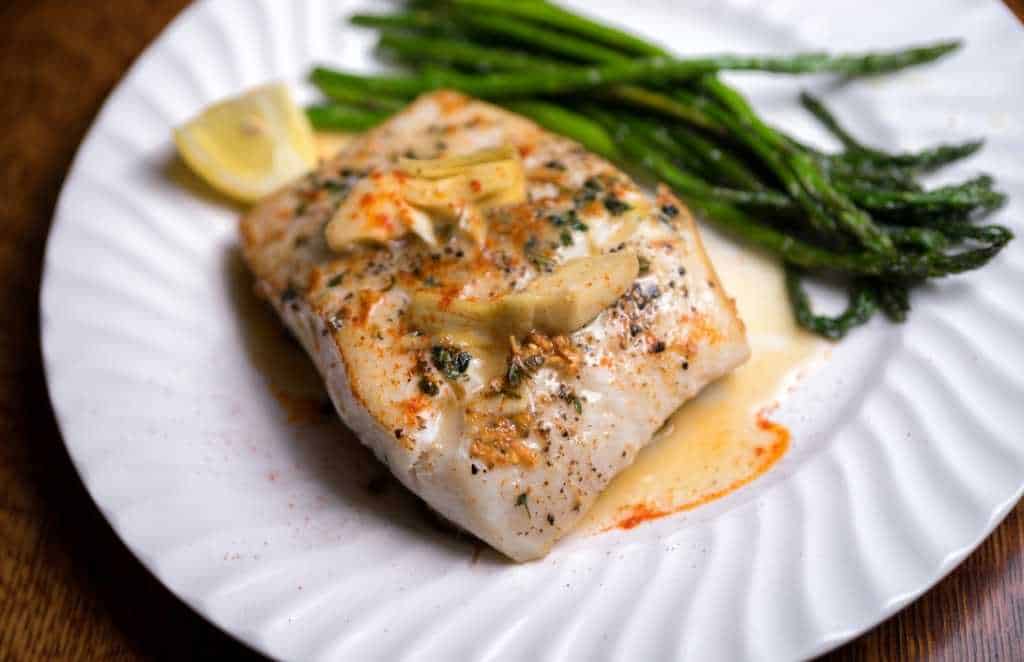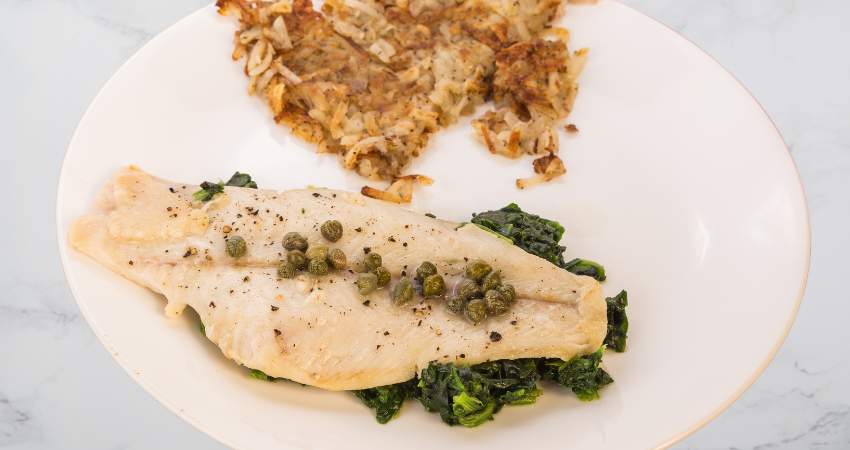Halibut vs Flounder – What’s the Difference? Let’s Compare
Halibut and flounder are often compared due to their similar flatfish shapes. Although there are various differences between the two fish. Therefore, let’s answer the question, what is the difference between halibut and flounder?
Halibut and flounder are different species although from the same flounder suborder Pieuronectoidei. Halibut provides a larger percentage of nutrients than flounder. Halibut has a firmer texture and is less flakey than flounder. Halibut costs approximately $17 more per pound than flounder.
This article will compare both species tastes, textures, cooking methods, costs, mercury levels and whether one can substitute for the other in recipes. In addition, I’ll do a side-by-side comparison of their nutrients, habitats, size, weight and more.
As a Certified Health Coach, many of my clients inquire about seafood. In addition to coaching clients about flounder and halibut, I’ve purchased, researched and consumed both fish for over 20 years.
Halibut and Flounder Nutrition Value
The following table is a side-by-side comparison of all the nutrients per four ounces:
| Nutrient | Halibut, raw (4 Ounces) | Flounder, raw (4 Ounces) |
| Calories | 103 | 79 |
| Fat | 1.5 g | 2.2 g |
| Saturated Fat | 0.3 g | 0.5 g |
| Cholesterol | 56 mg | 51 mg |
| Protein | 21 g | 14 g |
| Omega-3 | 0.25 g | 0.31 g |
| B-6 | 0.6 mg | 0.1 mg |
| B-12 | 1.2 mcg | 1.2 mcg |
| Thiamin | 0.05 mg | 0.02 mg |
| Riboflavin | 0.03 mg | 0.02 mg |
| B5 | 0.3 mg | 0.4 mg |
| Niacin | 7.3 mg | 1.1 mg |
| Folate | 13.6 mcg | 5.6 mcg |
| Iron | 0.1 mg | 0.2 mg |
| Potassium | 493 mg | 181 mg |
| Magnesium | 26 mg | 20 mg |
| Phosphorus | 267 mg | 285 mg |
| Calcium | 7.9 mg | 23.8 mg |
| Zinc | 0.4 mg | 0.3 mg |
| Selenium | 51.7 mcg | 30.2 mcg |
Nutrient sources ((Nutrition Value: Fish, raw, Atlantic and Pacific, halibut)) ((Nutrition Value: Flounder, raw))
After examining the nutritional table above, it’s easy to see both fish are a good source of many vitamins and minerals. Therefore, which one is healthier?
Halibut is healthier than flounder due to its higher percentage of B vitamins and minerals. It provides more B6, thiamin, riboflavin, niacin, folate, potassium, magnesium, zinc and selenium. Halibut contains more protein and fewer total and saturated fats.
Flounder also contains a good number of of vitamins and minerals. It provides more omega-3 fatty acids, B5, iron, phosphorus and calcium.
Both species of fish contain the same amount of B12. Keep reading and find out why omega-3 fatty acids and the various vitamins and minerals are important to your health.
Halibut and Flounder Health Benefits
Both fish provide the same nutrients and therefore the same benefits. Although I broke down the benefits by which fish offers the higher percentage of each nutrient ((FDA: Seafood Nutrition Facts)).
Halibut Health Benefits
B Vitamins
The B vitamins provided by flounder and halibut fish include B1 (thiamin), B2 (riboflavin), B3 (niacin), B9 (folate) B6, B12 and B5. B vitamins help support the following:
- Energy levels.
- Red blood cells.
- Cardiovascular disease.
- Digestion.
- Nerve function.
- Brain function.
Potassium
Potassium helps the body get rid of excess sodium which helps reduce fluid build-up. These help keep systolic and diastolic blood pressure lower ((American Heart Association: How Potassium Can Help Control High Blood Pressure)).
The more potassium you consume, the more sodium your body will lose. Consuming too much sodium or not enough potassium throws off the delicate balance the kidneys need to remove the excess water1.
According to Harvard Health, a number of studies have shown a connection between low potassium levels and increased blood pressure2.
Magnesium
Magnesium calms and relaxes the whole body including blood vessels. Magnesium has been shown to help improve sleep related problems like insomnia ((National Institutes of Health: Magnesium)).
Magnesium helps keep blood pressure levels balanced and stable. A recent study researched 22 studies and concluded magnesium supplementation decreased diastolic and systolic blood pressure3.
Magnesium in halibut helps control muscle and nerve function, blood sugar and blood pressure.
In the muscles and heart, magnesium competes with calcium to help the muscles relax after contracting. When the body is low in magnesium, calcium can over stimulate the heart muscle’s cells causing a rapid or irregular heartbeat.
Selenium
Selenium is a nutrient which doesn’t receive much press. I’m unsure why many don’t write about it more because studies4 show selenium may help to protect the following:
- Heart disease
- Thyroid
- The immune system
- Cognitive issues
Folate
Also known as B9, a deficiency in folate has been linked to depression in people with epilepsy. Low folate has been associated with an increased risk of depression5.
Folic acid (B9) can improve blood flow and help blood vessels to relax. In a study of over 3,000 women, the findings suggest that using folic acid containing supplements may lower the risk for high blood pressure during pregnancy and preeclampsia6.

Find out how flounder compared to cod in my article, Flounder vs Cod: Is One Better? Let’s Compare.
Flounder Health Benefits
Omega 3 Fatty Acids
Flounder provides 0.31 grams of omega-3 and halibut 0.25 grams per four ounces raw. Omega-3 fatty acids are heart healthy and help keep arteries healthy. The omega-3s may help with the following:
- Keeping bad cholesterol low.
- Keeping good cholesterol high.
- Reducing inflammation.
- Reducing plaque build-up.
- Lowering triglycerides
- Help keep the heart rhythms more normal.
DHA and EPA, two of the fatty acids, are associated with lowering blood pressure and improving the health of blood vessels ((National Center for Biotechnology: Marine Omega-3 Supplementation and Cardiovascular Disease)).
Studies suggest omega-3s can help reduce joint pain and stiffness in people with rheumatoid arthritis. They may also boost the effectiveness of anti-inflammatory drugs.
Phosphorus
Phosphorus has been shown in scientific research to help with the following:
- Muscle recovery after exercise.
- Muscle contraction.
- Help the body store and manage energy.
- Help the kidneys remove waste.
- Promote healthy nerve conduction.
- Promote teeth and bone strength.
Calcium
Calcium is important for blood pressure and the heart. Harvard Health reports calcium helps maintain blood pressure because it helps to control the relaxing and tightening of blood vessels7.
Calcium also helps the following:
- Build and maintain strong bones.
- Muscles need calcium to function properly.
- Improve nerve function.
Found out how halibut compared to Mahi Mahi and which one provides more vitamins and minerals in my article, Mahi Mahi vs Halibut: What’s The Difference? Let’s Compare.
Halibut vs Flounder: Tastes and Textures
One of the most important things people takes into consideration when choosing a fish species in a store or fishing is its taste. When comparing the two fish, halibut vs flounder, let’s take a close look at how they taste.
Halibut and flounder both have a similar mild to slightly sweet taste. Neither fish has a fishy flavor. Halibut has more meat and a firm texture. Flounder’s texture is more delicate than the firmer texture of halibut. Flounder is flakier and will separate easier when eating.
Flounder has a mild to slightly sweet flavor. It doesn’t taste oily and has a flaky, delicate texture. Flounder doesn’t not have a fishy flavor.
Halibut has a mild to sweet taste. Halibut has a form texture and is typically a thicker cut of fish.
I conducted original research on taste by polling my clients, readers and members of food groups. I asked which fish tastes better?
- 48% said they preferred the taste of flounder.
- 41% said they preferred the taste of halibut.
- 11% said they had no preference.
I did more original research by setting up a blind taste test at my home. Both fish were prepared the same way. Three out of four people chose flounder.
Substitutions
When preparing recipes for dinner it’s not always possible to locate the type of fish in a store or while fishing. If you have some halibut, you may wonder if you can substitute one for the other.
Halibut can substitute for flounder due to their similar mild to sweet tastes. Flounder’s texture is more delicate and may fall apart easier when cooking. Therefore, when substituting halibut for flounder any cooking method may be utilized.
Flounder can substitute for halibut due to their similar tastes. Due to flounder’s more delicate texture, when substituting, avoid grilling and instead bake, broil, poach or fry. Other halibut substitutes include the following:
- Rainbow trout
- Cod
- Flounder
- White Sea bass
The best flounder substitutes are:
- Porgy
- Cod
- Smelt
- Trout
- Tilapia
When substituting either one always stick to the following:
- Same size and weight.
- Stick with similar fillets, whole fillet or cross section.
- Stick with skinless or skin when the recipe calls for one.
- Texture is more important for certain cooking methods. Like using a firmer texture when grilling8.
Check out substitutions and a complete comparison between halibut and salmon in my article, Halibut vs Salmon: Which is Better?
How Much Does Halibut and Flounder Cost
The costs for fish will vary depending on how they’re are caught fishing and where they are sold. When purchasing fish, be sure to check the label. Therefore, lets examine which one is more expensive.
Halibut is more expensive than flounder. The average cost for wild caught flounder is $14.49 per pound while the average cost for wild caught halibut is $33.49 per pound.
Halibut is so expensive for the following reasons:
- They grow slowly and are difficult to find.
- The demand is high.
- Farming them is very labor intensive.
- The shipping costs are expensive.
I conducted original research by checking the prices of both fish in various different stores.
First, I checked the local Freshdirect online supermarket for the current prices.
- Wild flounder fillet
- $17.99 per pound
- Fresh, wild halibut fillet
- $29.99 per pound
I also checked shoprite supermarket:
- Fresh wild halibut fillet
- $36.99 per pound
- Wild Atlantic flounder fillet
- $10.99 per pound

Mercury Levels
The EPA and The FDA have issued warnings and suggestions regarding mercury levels in fish and how often they should be consumed9. This is especially important for young infants, developing children and pregnant women.
They established a list of best fish, good species choices and ones to avoid based on their mercury levels. Therefore, let’s examine each fish and determine which one has more mercury.
Flounder has less mercury than halibut. Flounder is listed on the FDA’s best choices list and halibut on the good choices list regarding mercury levels. Halibut is a larger fish than flounder. Larger fish typically contain more mercury than smaller fish.
Everyone, especially if you’re pregnant, breast feeding or have a young child, always check with a physician prior to eating new foods or changing your dietary habits.
These mercury warnings can change over time or affect only a particular area or state. For any fish, check with your local EPA and FDA for the current recommendations especially while fishing10.
Find out about cod’s mercury and how it compared to halibut in my article, Halibut vs Cod: The Differences in Detail.
Halibut vs Flounder: Habitats, Size, Weight, Appearance?
Halibut and flounder are both flat fish. For that reason, many people ask, how can you tell the difference between a flounder and a halibut?
The easiest way to tell the difference between a flounder and a halibut is their body shape, tail fin and size. A halibut body is more elongated than the oval shape of the flounder. The flounder’s tail fin is rounded while the halibut’s tail fin is slightly forked. Halibuts weigh more and grow longer than flounders.
Scientific Classifications, Families, Species
Flounder is the name used to describe many species distantly related. The following are the better-known flounder species:
- Atlantic Ocean
- Gulf flounder (Paralichthys albigutta)
- Summer flounder (Paralichthys dentatus)
- Southern flounder (Paralichthys lethostigma)
- Winter flounder (Pseudopleuronectes americanus)
- Atlantic Halibut (Hippoglossus hippoglossus)
- European waters
- European flounder (Platichthys flesus)
- Witch flounder (Glyptocephalus cynoglossus)
- North Pacific Ocean
- Halibut (Hippoglossus stenolepis)
- Olive flounder (Paralichthys olivaceus)
Halibut have two species of fish both from the same family and genus.
Pacific halibut:
- Family: Pieuronectidae
- Genus: Hippoglossus
- Species: H. stenolepis
Atlantic halibut:
- Family: Pieuronectidae
- Genus: Hippoglossus
- Species: H. hippoglossus
If you take a close look at the list above you may notice halibut is listed under the flounder species. This may be confusing at first causing some people to say halibuts are flounder.
This raises a common question like, is California halibut a flounder?
California halibut or Hippoglossus stenolepis, is from one of the flounder families. The California halibut is part of the Pieuronectidae family, which is one of many families belonging to the flounder suborder Pieuronectoidei.
How About Summer Flounder?
Summer flounder are from a different family of flounder from the large-tooth flounder family. Also called a fluke, they are called summer flounder because the flatfish tend to migrate closer to the shore during the spring and summer when the degrees are higher.
Habitats
Halibut
- According to the National Oceanic and Atmospheric Administration, Pacific halibut primarily live in the Central Gulf of Alaska near Kodiak Island. Deep-sea fishing for halibut is a popular sport in Alaska.
- Atlantic Halibut are native to the temperate and arctic waters of the northern Atlantic Ocean. They can be found in Labrador, Greenland, Iceland, Bay of Biscay and Virginia.
Flounder
- The gulf, southern, summer and winter flounders are found in the western Atlantic Ocean.
- The European and witch flounders are found in European waters.
- The olive flounder can be found swimming in the North Pacific Ocean.
As a general rule most halibut species are found north and more flounder are found south.
Colors
- The upper part of halibut is dark and varies due to the color changing to blend in with the ocean floor. The change in color helps them avoid detection. The underside of the flatfish is lighter.
- The color of the flounder depends on the habitat. Flounders are typically brown colored with various red, orange, green and blue markings on the body.
Appearance
- Halibut have diamond shaped more elongated bodies than other flatfish. They have large arches in the lateral line over the pectoral fin. Their tails are a crescent shape. Both of their eyes are on the darker, upper side of their body.
- Flounder has an oval, flattened body with bulging eyes both located on one side of the head.
Size and Weight
- Then Atlantic Halibut female can grow up to 600 pounds. The males average 25-30 pounds and can weigh up to 100 pounds.
- A 20″ halibut weighs about 3 pounds.
- A 36″ halibut weighs about 20 pounds.
- A 58″ halibut weighs about 100 pounds.
The size of the flounder depends on which species. The average weight for flounders are the following:
- European flounder: 6.4 pounds
- Winter flounder: 4.4 pounds
- Witch flounder: 3 pounds
- Southern flounder: 11 pounds
- Olive flounder: Grow up to 20 pounds
The main difference between halibut and flounder is their size.
Age
- A halibut can live up to 50 years.
- A flounder can live up to 20 years.
Diet
Flounder consume the following:
- Zooplankton
- Small invertebrates
- Large invertebrates
- Bluefish
- Squid
- Shrimp
- Crabs
Halibut consume the following:
- Other fish
- Cod
- Haddock
- Herring
- Sand eels
- Pogge
- Large crustaceans

Fishing
The following are some fishing tips and guides.
The best time for fishing may vary depending on your location. In Texas, the best time to catch flounder is during their fall migration to the Gulf from October to December.
Flounder usually wait for the bait to come to them so it’s best to keep your bait moving.
Some of the best east coast spots for flounder and flatfish fishing are New Jersey, North Carolina and Florida. In the Gulf of Mexico Texas and Louisiana are great fishing spots.
If you have any questions about this flatfish article or other posts, don’t hesitate to email the details to us. You can find an email on our contact page. We’ll do our best to reply as soon as possible.
Read Next – More Fish vs Fish Articles!
White Perch vs White Bass: Which Is Better?
Spotted Bass vs Smallmouth Bass: What’s The Difference?
Sprats vs Sardines – AreThey Different? Let’s Compare
Rainbow Trout vs Brown Trout – What’s The Difference?
Tuna vs Mahi Mahi – What’s The Difference? Let’s Compare
- National Center for Biotechnology Information: The Effect of the Sodium to Potassium Ratio on Hypertension Prevalence: A Propensity Score Matching Approach [↩]
- Harvard Health: Potassium lowers blood pressure [↩]
- National Center for Biotechnology Information: Effect of magnesium supplementation on blood pressure: a meta-analysis [↩]
- National Institutes of Health: Selenium [↩]
- National Center for Biotechnology Information: Is Depression Related to Low Folate Levels in People with Epilepsy? An Observational Study and Meta-analysis [↩]
- Women And Birth: Folic acid supplement use and the risk of gestational hypertension and preeclampsia [↩]
- Harvard Health: Key minerals to help control blood pressure [↩]
- Sea Grant North Carolina: Fish Flavors and Substitutions [↩]
- FDA: Advice about Eating Fish [↩]
- National Center for Biotechnology Information: Mercury accumulation in largemouth bass (Micropterus salmoides) in a Florida lake [↩]
